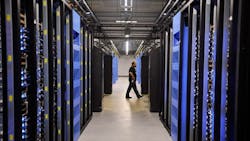Grainger Says New Data Center is First to be Certified by New LEED Standards
W.W. Grainger Inc., Lake Forest, Ill., says its new data center in Lake Forest is the first to be certified by the U.S Green Building Council's new LEED green building standards for data centers. According to a Grainger press release, this data center features an advanced cooling system where the energy used for cooling the facility is controlled by strictly managing the air flow, using outside air to cool the facility. As a result, Grainger expects the new data center to consume up to 50% less energy for cooling than similar data centers.
Data centers usually run nonstop, which means these facilities can consume up to 200 times more electricity than typical office spaces. Most of this energy is used to cool the building as temperatures from IT equipment housed in a data center can reach more than 100 degrees Fahrenheit. This Grainger data center's air cooling design is anticipated to have a best-in-class PUE rating of 1.2 at full capacity; the industry average is 2.0. Throughout planning and construction, Grainger's project team partnered with the U.S. Green Building Council to provide feedback about the new v4 BD+C standards, which were finalized more than seven months after the project broke ground. The team worked quickly to incorporate the new standards into the certification process. Details
